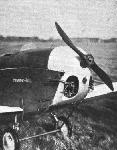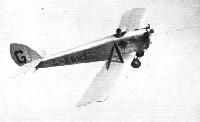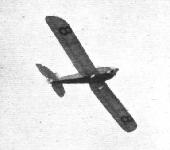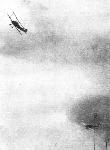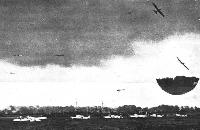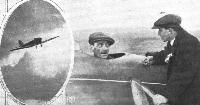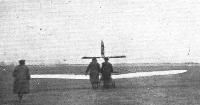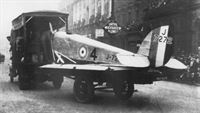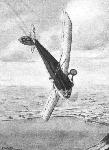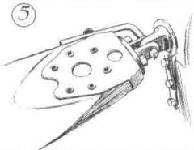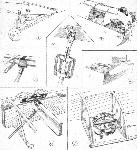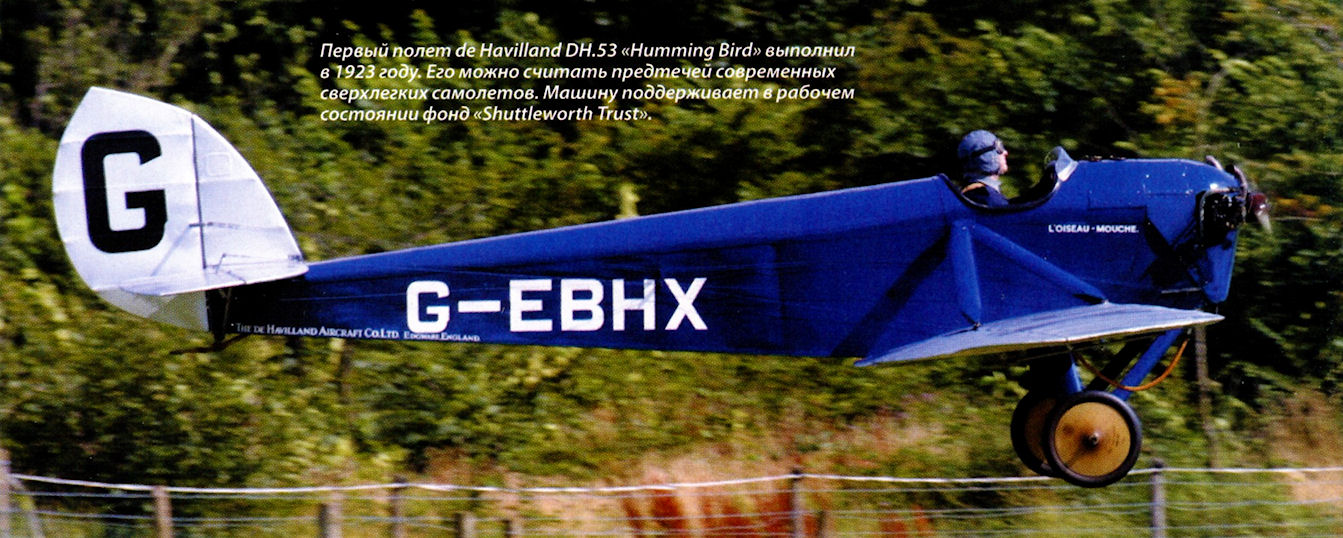
Варианты
- De Havilland - Humming Bird / D.H.53 - 1923 - Великобритания
- Clarke - Cheetah - 1929 - Великобритания
- RAE - Scarab - 1932 - Великобритания
de Havilland DH.53 Humming Bird
Первым сверхлегким самолетом фирмы "de Havilland" был DH.53 Humming Bird. Машину построили для конкурса авиеток на приз газеты "Daily Mail", состоявшегося в Лимпне, Кент, в октябре 1923 года.
Два небольших расчалочных моноплана оснастили мотоциклетными моторами Douglas объемом 750 см'. Первый из них впервые взлетел в сентябре. Несмотря на значительные проблемы с мотором, оба самолета успешно прошли испытания.
Для повышения надежности на авиетки поставили моторы Blackburne Tomtit и немного их переделали. В 1923 году первая авиетка Humming Bird была представлена на выставке в Брюсселе. Позднее она приняла участие в нескольких авиагонках вместе со вторым аэропланом, принадлежавшим группе офицеров ВВС Британии. Офицеры заменили двигатель на мотор ABC Scorpion в 35 л.с. (26 кВт), оказавшийся ненадежным.
Благодаря экономичности первой авиетки Humming Bird Министерство авиации заказало восемь таких машин для связи и летной практики. Еще пять построили для гражданских заказчиков, три отправили в Австралию, одну в Чехословакию и одну в СССР. Две последние авиетки Humming Bird использовались британскими военными в экспериментах с запуском их с дирижабля R-33 и последующим причаливанием в воздухе. После списания всех восьми самолетов из ВВС в 1927 году, шесть из них перешли к частным владельцам и летали еще несколько лет. Один сохранился в запасах Фонда Шаттлуорта ("Shuttleworth Thrust") в Олд-Уордене, отремонтированный (с заменой ряда узлов) после Второй мировой войны. Он иногда совершал полеты, но в 1980-е годы дважды терпел аварии из-за поломок двигателя. Его вернули в летное состояние только в 2001 году.
ТАКТИКО-ТЕХНИЧЕСКИЕ ХАРАКТЕРИСТИКИ
de Havilland DH.53 Humming Bird
Тип: одноместный сверхлегкий самолет
Силовая установка: поршневой V-образный мотор Blackburne Tomtit мощностью 26 л.с. (19 кВт)
Летные характеристики: максимальная скорость 117 км/ч на уровне моря; крейсерская скорость 97 км/ч на оптимальной высоте; начальная скороподъемность 69 м/мин; практический потолок 4570 м; дальность полета 241 км
Масса: пустого самолета 148 кг; максимальная взлетная 256 кг
Размеры: размах крыла 9,17 м; длина 5,99 м; высота 2,21 м; площадь крыла 11,61 м2
Описание:
- de Havilland DH.53 Humming Bird
- Flight, August 1923
THE DE HAVILLAND 53 LIGHT 'PLANE
Фотографии
-
Aeroplane Monthly 1978-12 / de Havilland D.H.53 /Preservation Profile/ (68)
Регистрационный номер: G-EBHX [18] -
Мировая Авиация 139
Регистрационный номер: G-EBHX [18] Первый полет de Havilland DH.53 "Humming Bird" выполнил в 1923 году. Его можно считать предтечей современных сверхлегких самолетов. Машину поддерживает в рабочем состоянии фонд "Shuttleworth Trust".
-
Aeroplane Monthly 1998-10 / R.Riding - A Broad experience (1)
Регистрационный номер: G-EBHX [18] Then ... D.H.53 Humming Bird G-EBHX parked next to Aldenham School’s cricket pavilion in 1928.
... and now. Same aircraft, same place, same viewpoint - but 70 years on, on June 14,1998. -
Flight 1923-09 / Flight
Регистрационный номер: G-EBHX [18] THE D.H.53: Three-quarter rear view. This illustration gives a good idea of the shape of wings and tail, also indicates that the view from the pilot's cockpit is exceptionally good.
-
Flight 1936-04 / Flight
The D.H. 53 (750 c.c. flat-twin Douglas).
-
Jane's All the World Aircraft 1980 / Encyclopedia of Aviation - Aircraft A-Z - v3
de Havilland D.H.53 Humming Bird
-
Flight 1923-09 / Flight
Регистрационный номер: G-EBHX [18] THE D.H.53: Front view, showing dihedral, wing bracing, struts, etc.
-
Aeroplane Monthly 1978-12 / de Havilland D.H.53 /Preservation Profile/ (68)
Регистрационный номер: G-EBHX [18] Humming Bird prototype G-EBHX at Stag Lane after completion, 1923
-
Flight 1923-09 / Flight
Регистрационный номер: G-EBHX [18] THE D.H.53: Three-quarter front view, and, on the left, a larger view of the engine and undercarriage.
-
Flight 1924-06 / Flight
THE D.H.53 LIGHT MONOPLANE: This machine, fitted with a 696 c.c. Blackburne engine, has been sent to Prague, where it will give demonstration flights at the Kbely Aerodrome. It was on a similar machine that Mr. Alan J. Cobham flew from London to Brussels in less than four hours.
-
Flight 1923-11 / Flight
THE D.H.53 LIGHT MONOPLANE AT HENDON: A "close-up" of the inverted Blackburne engine.
-
Aeroplane Monthly 1985-11 / H.Morris - The Barnstormer's Apprentice (1)
Регистрационный номер: G-EBHX [18] F. J. V. Holmes' D.H.53 G-EBHX at Barton in 1930. This was the “small flat-twin engined low-wing monoplane” which the author discovered in a neglected corner of the hangar. The aircraft is now with the Shuttleworth Collection.
-
Aeroplane Monthly 1978-12 / de Havilland D.H.53 /Preservation Profile/ (68)
Регистрационный номер: G-EBHX [18] At Stag Lane in 1925, as flown to Brussels by Alan Cobham
-
Мировая Авиация 104
Регистрационный номер: G-EBHX [18] В 1955 году авиетку Humming Bird, ныне принадлежащую Фонду Шаттлуорта, нашли в частном саду в сильно поврежденном состоянии и восстановили с помощью технической школы фирмы "de Havilland".
-
Aeroplane Monthly 1978-12 / de Havilland D.H.53 /Preservation Profile/ (68)
Регистрационный номер: G-EBHX [18] Being flown at Old Warden by Desmond Penrose, June 1975
-
Flight 1924-10 / Flight
Регистрационный номер: G-EBHX [18] THE LIGHT 'PLANE RACE FOR THE GROSVENOR CHALLENGE CUP: In 7 Cobham is seen standing the de Havilland 53 on its wing tip while rounding the aerodrome turning point.
-
Aeroplane Monthly 1985-04 / R.Riding - De Havilland D.H.53 /British pre-war ultralights/ (49)
Регистрационный номер: G-EBHX [18] Desmond Penrose flying Shuttleworth's ABC Scorpion-powered D.H.53 G-EBHX in 1974.
-
Aeroplane Monthly 1978-12 / de Havilland D.H.53 /Preservation Profile/ (68)
Регистрационный номер: G-EBHX [18] Chris Capper flies the restored prototype from Hatfield, 1960
-
Aeroplane Monthly 1978-12 / de Havilland D.H.53 /Preservation Profile/ (68)
Регистрационный номер: G-EBHX [18] At Hatfield, July 12, 1974, en route to Shuttleworth after its third rebuild
-
Aeroplane Monthly 1983-08 / P.Jarrett - Grapevine
Регистрационный номер: G-EBHX [18] Now on display in Old Warden's de Havilland Hangar following a speedy restoration is D.H.53 Hummingbird G-EBHX.
-
Aeroplane Monthly 1985-04 / R.Riding - De Havilland D.H.53 /British pre-war ultralights/ (49)
Регистрационный номер: G-EBHX [18] The unregistered G-EBHX at Lympne in October 1923 with its wings detached and clipped to the fuselage for the transport tests.
-
Aeroplane Monthly 1985-04 / R.Riding - De Havilland D.H.53 /British pre-war ultralights/ (49)
Регистрационный номер: G-EBHZ [4] The two prototype D.H.53s at Lympne in October 1923 with Sylvia II, later G-EBHZ, nearer the camera.
-
Flight 1926-08 / Flight
Регистрационный номер: G-EBHZ [4] THE BOURNEMOUTH AVIATION MEETING: The line up for the first event on Sunday - the Private Club Handicap, won by Capt. de Havilland's "Moth" (the third machine on the left).
Другие самолёты на фотографии: De Havilland Moth / D.H.60 - Великобритания - 1925
-
Aeroplane Monthly 1978-05 / A.Jackson - Crawford Monoplane /British pre-war ultralights/
Регистрационный номер: G-EBHZ [4] The similarity between the Crawford monoplane and the D.H.53 is apparent in this photograph of Scorpion-powered D.H.53 G-EBHZ, flown by Flg Off G. E. F. Boyes at Lympne on July 31, 1925.
-
Flight 1926-09 / Flight
Регистрационный номер: G-EBHZ [4] A very fine little Machine: The de Havilland 53 belonging to the Seven Aeroplane Club flies like a small Scout in spite of the fact that its engine is an A.B.C. of some 35 h.p. only.
-
Aviation Historian 1 / P.Jarrett - Under the windstocking
Регистрационный номер: G-EBQP [4], J7326 [4] De Havilland D.H.53 Humming Bird G-EBQP began life as J7326, one of eight ordered for evaluation as primary trainers for the RAF, and was also earmarked for experimental launch and retrieval trials operating from the rigid airship R33. at that time it had a 32 h.p. Bristol Cherub engine. Subsequently it was one of several ex-RAF D.H.53s made airworthy by P.G.N. Peters and his fellow members of the Royal aircraft establishment aero Club at Farnborough. Granted its Certificate of Airworthiness (C of A) on May 13, 1927, in January 1928 its ownership passed to Fg Off A.F. Scroggs at Henlow. It ended its life in a crash at Hamble on July 21, 1934.
-
Flight 1927-08 / Flight
Регистрационный номер: G-EBQP [4], J7326 [4] THE NOTTINGHAM FLYING MEETING: Event 1 on Monday's programme - F/O. Mackenzie Richards starting at scratch in the Papplewick Stakes on the D.H. 53.
-
Aeroplane Monthly 1985-04 / R.Riding - De Havilland D.H.53 /British pre-war ultralights/ (49)
Регистрационный номер: G-EBQP [4], J7326 [4] D.H.53 G-EBQP was destroyed in a crash at Hamble on July 21, 1934.
-
Aeroplane Monthly 1985-04 / R.Riding - De Havilland D.H.53 /British pre-war ultralights/ (49)
Регистрационный номер: G-EBRJ This D.H.53 was owned for a while by the Tellus Super Vacuum Cleaner Company Ltd. It was scrapped in 1930.
-
Aeroplane Monthly 1985-04 / R.Riding - De Havilland D.H.53 /British pre-war ultralights/ (49)
Регистрационный номер: G-EBRK Mr. R. W. Knight, who won the Landing Competition in his D.53 ("Cherub").
G-EBRK crashed at Duxford in 1932. -
Flight 1930-04 / Flight
Регистрационный номер: G-EBRW THE LIGHTER SIDE: The little D.H. 53 used for a comic turn.
-
Aeroplane Monthly 1985-04 / R.Riding - De Havilland D.H.53 /British pre-war ultralights/ (49)
Регистрационный номер: G-EBXN This is the D.H.53 monoplane (Bristol "Cherub" engine), owned by the R.A.E. Club at Farnborough, who have reconditioned it to the extent that only the wings, engine, etc., were not built by them.
D.H.53 G-EBXN survived until 1940 when it was destroyed in a hangar fire. -
Air Pictorial 1956-07 / Photos by request
Регистрационный номер: VH-UAC, G-AUAC MODIFIED D.H.53 - Humming Bird single-seat ultra-light, built at Stag Lane in 1924 (c/n. 103; ex G-AUAC, old Australian registration form). Standard production motor (32-h.p. Bristol Cherub III 2-cylinder engine) has been replaced by heavier 35-40-h.p. ABC Scorpion 3-cylinder motor resulting in cut-back nose, with airscrew just clearing airframe. Prototype (1923, c/n. 101, G-EBHX) had 700-c.c. Blackburne engine giving maximum speed of 76 m.p.h. for a.u.w. 490 lb. Span 30 ft. 1 in.; length 19 ft. 8 in.
-
Flight 1923-11 / Flight
WINNING LIGHT 'PLANES AT HENDON: Capt.H. S. Broad on the D.H.53 monoplane (Blackburne engine), winner of the Handicap Race
-
Flight 1925-08 / Flight
Boyes on the D.H.53
-
Flight 1925-11 / Flight
A LYMPNE REMINISCENCE: Bert Hinkler on the Avro "Avis" leading Boyes on one of the D.H.53's. The picture gives some impression of Hinkler's masterly handling of the "Avis."
Другие самолёты на фотографии: Avro Avis / Type 562 - Великобритания - 1924
-
Flight 1923-10 / Flight
DE HAVILLAND MONOPLANES: The lower photograph shows Major Hemming wheeling out No. 12 for a flight at Lympne. This machine is known as the "Hemming-Bird," while the second de Havilland is called the "Humming-Bird." The upper pictures show No. 8 in flight, piloted by Capt. de Havilland, and No. 12, piloted by Major Hemming.
-
Flight 1924-09 / Flight
REMINISCENCES OF LAST YEAR'S LYMPNE COMPETITIONS: The photograph shows Mr. Broad flying the de Havilland 53, while the inset is a view from underneath of the "Wren" on which Longton tied with James for the consumption prize.
-
Flight 1926-09 / Flight
THE RACE FOR THE GROSVENOR CHALLENGE CUP: No less than 21 machines faced the starter for this race, a record number. The result was that machines frequently got bunched together at the turning points. Our photograph show one of some such incidents. In 1 are seen the D.H. 53, the Farnborough "Cygnet," and the Cranwell biplane approaching the aerodrome turning point.
Другие самолёты на фотографии: Comper Cranwell IV / CLA.4 - Великобритания - 1926Hawker Cygnet - Великобритания - 1924
-
Flight 1925-07 / Flight
THE LIGHTER SIDE OF THE R.A.F. DISPLAY: Event No. 3, the Light Aeroplane Race, open to the Directorates of the Air Ministry, on D.H. 53's. Above, four of the six D.H. 53's entered finishing their first lap (about 5 miles). Below, the line up of the six youngsters before the start. Inset, the winning machine (Wing-Comdr. W. S. Douglas, M.C., D.F.C., "Equipment") finishing.
-
Flight 1928-04 / Flight
Регистрационный номер: G-EBQP [4], J7326 [4] A LITTLE COMIC RELIEF: Mr. Cousins caused much amusement by arriving in a D.H. 53, wearing a bowler hat, which he raised as he flew past the enclosures. On the right he is seen with attache case and umbrella after alighting.
-
Flight 1923-10 / Flight
AIR-COMMODORE C. A. H. LONGCROFT TRIES THE DE HAVILLAND LIGHT 'PLANE: Our photograph shows the Commodore discussing the machine with Capt. Broad, while in the inset the machine is seen on a pretty banked turn. The machine was also flown by Wing-Commander Pretyman.
-
Flight 1925-02 / Flight
A D.H.53 IN AUSTRALIA: In the cockpit, "Capt. F. W. Follett, Superintendent of Aircraft, Civil Aviation Branch of the Department of Defence. Our photograph also shows Capt. Reid, Mr E. J. Hart, Editor of "Aircraft" (in the sweater, Mr. McArthur Onslow (in front of Follett), Capt. Jones. M.C., D.F.C., Superintendent of Flying Operations and pilot of the G-AUAB round-Australia D.H.50, is talking to Col. Brinsmead, O.B.E., M.C., Controller of Civil Aviation.
-
Flight 1923-10 / Flight
Perfectly Simple: Major Hemming and an assistant at Lympne wheeling out the de Havilland monoplane ''Sylvia II" by holding on to the propeller and letting the tail rise off the ground.
-
Aeroplane Monthly 1980-10 / K.Wixey - Parnall Pixie /British pre-war ultralights/
THE LIGHTER SIDE OF THE R.A.F. PAGEANT: Two light 'planes, which led in the "Fly Past": the Parnall "Pixie" and the D.H.53, both fitted with Blackburne "Tomtit" engines.
Parnall Pixie II J7323 at the 1924 RAF Hendon Air Pageant, re-engined with a 698cc Blackburne Tomtit engine.Другие самолёты на фотографии: Parnall Pixie - Великобритания - 1923
-
Flight 1923-10 / Flight
LIGHT 'PLANE COMPETITIONS: The official "shed." No. 8, one of the de Havilland machines, and No. 13, the Handasyde monoplane, in the shed ready for filling up.
Другие самолёты на фотографии: Handasyde monoplane - Великобритания - 1923
-
Aeroplane Monthly 1985-12 / H.Morris - The Barnstormer's Apprentice (2)
Home. It was in this Barton hangar that the author served his apprenticeship. On the right is cricketer Peter Eckersley’s Avro Avian. Other aircraft include Avro 504Ks, a D.H.53 and a D.H.9.
Другие самолёты на фотографии: Avro Avian / Type 594/616 - Великобритания - 1926Avro Avro 504 - Великобритания - 1913De Havilland D.H.9 - Великобритания - 1917
-
Aeroplane Monthly 1985-04 / R.Riding - De Havilland D.H.53 /British pre-war ultralights/ (49)
A Sign of the Times: A batch of 12 D.H.53 light 'planes coming through the shops at Stag Lane.
-
Air-Britain Aeromilitaria 1988-02
Регистрационный номер: J7272 [3], G-EBTT [3] D.H.53 Humming Bird J-7272; at Northolt ?
-
Aeroplane Monthly 1985-04 / R.Riding - De Havilland D.H.53 /British pre-war ultralights/ (49)
Six RAF D.H.53s at the RAF Pageant at Hendon in 1925.
-
Flight 1925-11 / Flight
Регистрационный номер: J7272 [3], G-EBTT [3] THE R.A.F. IN LORD MAYOR'S PROCESSION: A workshop lorry towing a D.H.53.
-
Aeroplane Monthly 1985-04 / R.Riding - De Havilland D.H.53 /British pre-war ultralights/ (49)
Регистрационный номер: J7272 [3], G-EBTT [3] Representing the RAF at the 1925 Lord Mayor's Show was D.H.53 J7272, later G-EBTT, being towed through London on a trailer.
-
Flight 1923-11 / Flight
The D.H.53 light monoplane "stunting" at Hendon meeting.
-
Flight 1923-10 / Flight
LIGHT 'PLANES AT LYMPNE: Some constructional details. 5. Wing strut attachment to fuselage on de Havilland monoplane.
-
Flight 1923-09 / Flight
THE D.H.53 LIGHT 'PLANE: Some constructional details. 1, General view of the undercarriage, of which some of the details are shown in 2; 3 shows the engine mounting, cowling, tank, etc.; and 4, the very simple engine plate. The fitting for one of the wing-tip cane skids is shown in 5. In 6 the construction of spars, ribs, and compression struts is indicated, as well as the substantial fitting for the wing struts. Details of the aileron sprocket mounting are shown in 7.
-
Flight 1923-09 / Flight
D.H.53 Light 'Plane 750 c.c. Douglas Engine
- Фотографии











